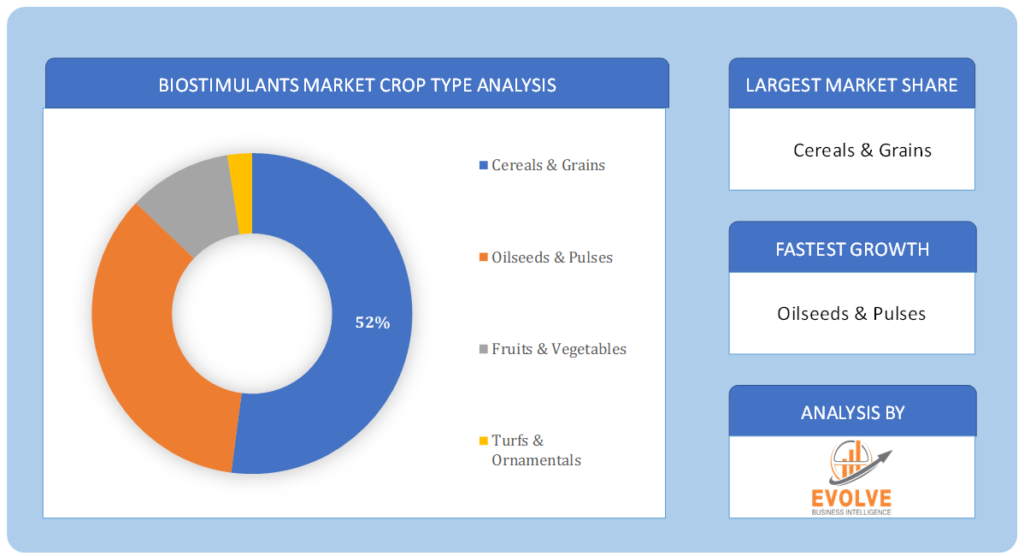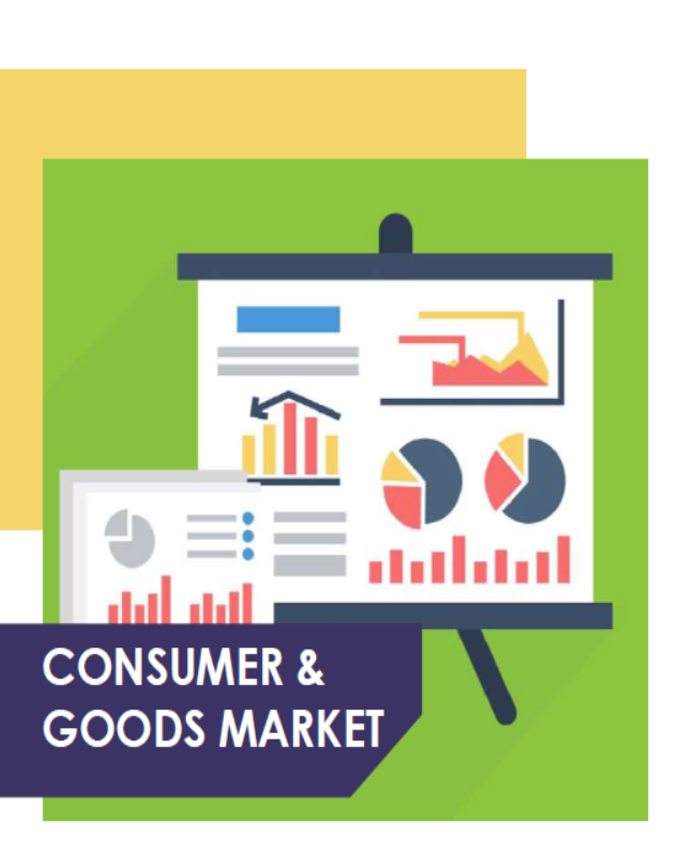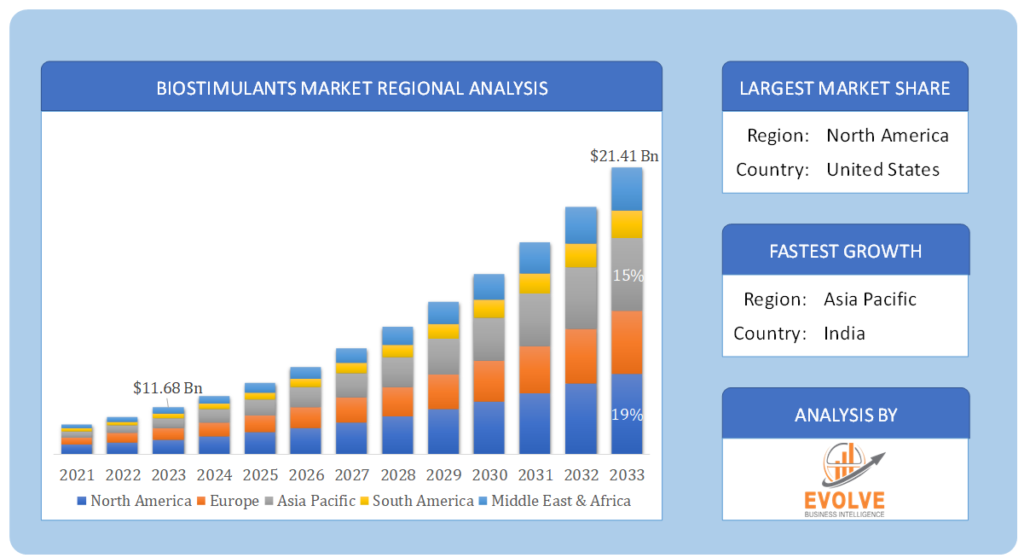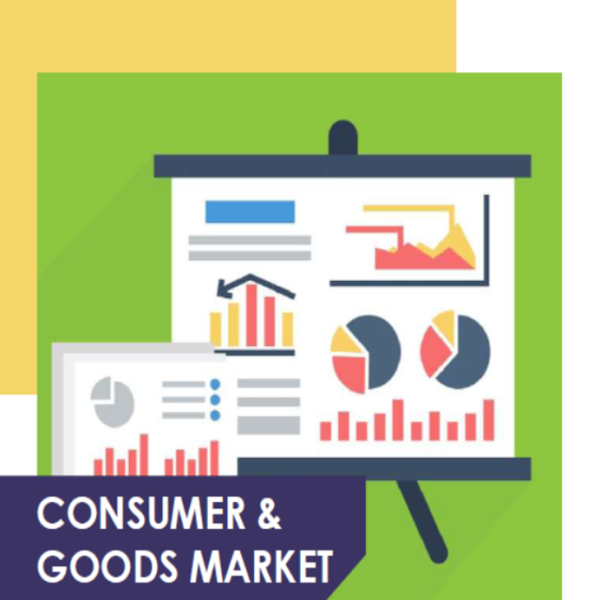Biostimulants Market Overview
The Biostimulants Market Size is expected to reach USD 21.41 Billion by 2033. The Biostimulants Market industry size accounted for USD 11.68 Billion in 2023 and is expected to expand at a compound annual growth rate (CAGR) of 7.85% from 2023 to 2033. Biostimulants are agricultural products or substances that enhance plant growth and development by stimulating natural processes. These products are used to improve the efficiency of nutrient uptake, enhance tolerance to abiotic stresses (such as drought, salinity, and extreme temperatures), and promote overall plant health and vigor. The Biostimulants Market refers to the commercial landscape and trade surrounding these products. It encompasses the production, distribution, and sale of biostimulant products to farmers, growers, and agricultural professionals. The market has been witnessing significant growth in recent years due to factors such as the increasing demand for sustainable agriculture practices, growing awareness about the environmental impact of synthetic chemicals, and the need for higher agricultural productivity to meet global food demand.
Global Biostimulants Market Synopsis
COVID-19 pandemic led to disruptions in transportation and logistics, which affected the supply of raw materials and finished biostimulant products. Restrictions on movement and trade barriers hindered the smooth flow of goods across borders. The pandemic highlighted the importance of food security and the resilience of agricultural systems. As a result, there was a growing emphasis on sustainable agriculture practices, including the use of biostimulants, to improve crop yields and optimize resource utilization. The pandemic also affected the regulatory environment for biostimulants, as authorities adapted their focus to address the immediate health crisis. Some regulatory processes for biostimulant registration and approval might have been delayed or affected.
Biostimulants Market Dynamics
The major factors that have impacted the growth of Biostimulants are as follows:
Drivers:
Ø Increasing demand for sustainable agriculture
With growing concerns about environmental sustainability and the need to reduce the environmental impact of agricultural practices, there has been a rising demand for biostimulants as a more sustainable alternative to chemical fertilizers and pesticides. The reduction in arable land and the scarcity of water resources have put pressure on farmers to increase crop productivity. Biostimulants offer a way to optimize nutrient uptake, improve crop resilience, and enhance overall plant health, thereby increasing yields without expanding agricultural land. Ongoing research and development efforts have led to the discovery of new biostimulant formulations and technologies, making them more effective and efficient in enhancing plant growth and stress tolerance.The increasing popularity of organic farming practices has driven the demand for biostimulants, as they align with the principles of organic agriculture and can be used as part of organic farming inputs.
Restraint:
- Limited awareness and understanding
Lack of standardized regulations: The biostimulant industry faced challenges due to the absence of globally harmonized regulations and definitions. Different countries and regions had varying regulatory frameworks, leading to uncertainties and complexities for market players seeking to navigate international trade. Despite the growing interest in biostimulants, there was still a lack of awareness and understanding among some farmers and growers about the benefits and proper use of these products. Educating potential customers about biostimulants’ effectiveness and value remained a challenge. Ensuring consistent and reliable performance of biostimulant products across different crops, regions, and growing conditions was a concern. The efficacy of biostimulants could vary depending on various factors, leading to skepticism among some potential users. The biostimulants market witnessed increasing competition as more companies entered the space. Established players and new entrants vied for market share, potentially leading to price pressures and reduced profit margins.
Opportunity
:
⮚ Growing demand for sustainable agriculture
With a growing global population, there is a rising demand for sustainable agricultural practices that minimize the environmental impact while ensuring food security. Biostimulants offer an eco-friendly and sustainable solution to enhance crop productivity and resilience. Ongoing research and development efforts have been leading to the discovery of innovative biostimulant formulations and technologies. These advancements present opportunities to develop more effective and efficient products, expanding the range of crops and growing conditions where biostimulants can be applied. The organic agriculture industry has been experiencing steady growth due to increasing consumer awareness of health and environmental benefits. Biostimulants align with organic farming principles and provide an opportunity for manufacturers to cater to the organic farming market. Governments and private investors have been recognizing the importance of agriculture in ensuring food security and sustainability. Increased investment in agriculture, research, and development can drive innovation and market expansion for biostimulants.
Biostimulants Market Segment Overview
By Crop Type
 Based on Crop Type, the market is segmented based on Cereals & Grains, Oilseeds & Pulses, Fruits & Vegetables and Turfs & Ornamentals. The cereals and grains segment represents a significant share of the Biostimulants Market. Biostimulants are applied to crops like wheat, corn, and rice to boost their resilience against environmental stressors and improve yields. Biostimulants play a crucial role in improving the quality and yield of fruits and vegetables, making them popular in horticultural applications. They are used to enhance fruit setting, improve fruit size and color, and extend shelf life. Biostimulants are used in the maintenance of lawns, golf courses, and ornamental gardens to promote healthy growth, stress tolerance, and aesthetic appeal.
Based on Crop Type, the market is segmented based on Cereals & Grains, Oilseeds & Pulses, Fruits & Vegetables and Turfs & Ornamentals. The cereals and grains segment represents a significant share of the Biostimulants Market. Biostimulants are applied to crops like wheat, corn, and rice to boost their resilience against environmental stressors and improve yields. Biostimulants play a crucial role in improving the quality and yield of fruits and vegetables, making them popular in horticultural applications. They are used to enhance fruit setting, improve fruit size and color, and extend shelf life. Biostimulants are used in the maintenance of lawns, golf courses, and ornamental gardens to promote healthy growth, stress tolerance, and aesthetic appeal.
By Application
Based on Application, the market has been divided into Foliar Treatment, Soil Treatment and Seed Treatment. Foliar application involves spraying biostimulant solutions directly onto plant leaves. This method allows for rapid nutrient absorption and is often used to address specific nutrient deficiencies or stress conditions. Soil treatment involves applying biostimulants to the soil before planting or during crop growth. This method enhances soil fertility, nutrient availability, and microbial activity, benefiting the entire plant’s development. Biostimulants can be applied directly to seeds before planting, promoting early root development and improving seedling vigor.
By Form
Based on Form, the market has been divided into liquid and dry. Liquid biostimulants are the most common form and are easy to apply through various irrigation systems or as foliar sprays. Dry biostimulants are available in powdered or granulated forms, and they can be mixed with soil or applied as seed treatments.
Global Biostimulants Market Regional Analysis
Based on region, the global Biostimulants Market has been divided into North America, Europe, Asia-Pacific, the Middle East & Africa, and Latin America. North America is projected to dominate the use of the Biostimulants Market followed by the Asia-Pacific and Europe regions.
 North America Market
North America Market
North America has indeed emerged as the fastest-growing market for the Biostimulants Market. The North American Biostimulants Market, including the United States and Canada, was one of the leading markets for biostimulants. The region’s market growth was driven by the increasing adoption of sustainable agriculture practices, a focus on reducing chemical inputs, and the need to improve crop resilience and productivity. Strong research and development efforts and favorable government policies supporting biostimulants’ use also contributed to the market’s expansion in this region.
Asia-Pacific Market
The Asia-Pacific region holds a dominant position in the Biostimulants Market. The Asia-Pacific region witnessed substantial growth in the Biostimulants Market, driven by countries like China, Japan, India, and Australia. Rising population, increasing food demand and the need for sustainable agricultural practices supported the market’s expansion in this region. The adoption of advanced agricultural technologies, including biostimulant applications, helped improve crop yields and enhance food security.
Competitive Landscape
The global Biostimulants Market is highly competitive, with numerous players offering a wide range of software solutions. The competitive landscape is characterized by the presence of established companies, as well as emerging startups and niche players. To increase their market position and attract a wide consumer base, the businesses are employing various strategies, such as product launches, and strategic alliances.
Prominent Players:
- BASF SE
- Isagro Group
- Sapec Agro S.A.
- Tradecorp
- Biolchim SpA
- Novozymes A/S
- Platform Specialty Products Corp.
- Mosiac Company
- Valagro SpA
- Koppert B.V.Italpollina SAP
Key Development
In February 2022, The Mosaic Company, a fertilizer manufacturer, acquired Plant Response Inc., leading to an enhanced presence and the ability to develop sustainable products and solutions for customers, thereby strengthening their position in the market.
In September 2021, Tradecorp introduced Biimore ly, a biostimulant derived from plant fermentation. Biimore comprises a distinctive blend of primary and secondary compounds, L-α amino acids, vitamins, sugars, and trace amounts of other natural compounds, providing a unique composition for enhanced agricultural performance.
Scope of the Report
Global Biostimulants Market, by Crop Type
- Cereals & Grains
- Oilseeds & Pulses
- Fruits & Vegetables
- Turfs & Ornamentals
Global Biostimulants Market, by Application
- Foliar Treatment
- Soil Treatment
- Seed Treatment
Global Biostimulants Market, by Form
- Liquid
- Dry
Global Biostimulants Market, by Region
- North America
- US
- Canada
- Mexico
- Europe
- UK
- Germany
- France
- Italy
- Spain
- Benelux
- Nordic
- Rest of Europe
- Asia Pacific
- China
- Japan
- South Korea
- Indonesia
- Austalia
- Malaysia
- India
- Rest of Asia Pacific
- South America
- Brazil
- Argentina
- Rest of SouthAmerica
- Middle East &Africa
- Saudi Arabia
- UAE
- Egypt
- SouthAfrica
- Rest of Middle East & Africa
| Parameters | Indicators |
|---|---|
| Market Size | 2033: $21.41 Billion |
| CAGR | 7.85% CAGR (2023-2033) |
| Base year | 2022 |
| Forecast Period | 2023-2033 |
| Historical Data | 2021 |
| Report Coverage | Revenue Forecast, Competitive Landscape, Growth Factors, and Trends |
| Key Segmentations | Crop Type, Application, Form |
| Geographies Covered | North America, Europe, Asia-Pacific, Latin America, Middle East, Africa |
| Key Vendors | BASF SE, Isagro Group, Sapec Agro S.A., Tradecorp, Biolchim SpA, Novozymes A/S, Platform Specialty Products Corp., Mosiac Company, Valagro SpA, Koppert B.V.Italpollina SAP |
| Key Market Opportunities | • The growing demand for sustainable agriculture • Increasing investment in agriculture |
| Key Market Drivers | • Increasing demand for sustainable agriculture • Decline in arable land and water resources |
REPORT CONTENT BRIEF:
- High-level analysis of the current and future Biostimulants Market trends and opportunities
- Detailed analysis of current market drivers, restraining factors, and opportunities in the future
- Biostimulants Market historical market size for the year 2021, and forecast from 2023 to 2033
- Biostimulants Market share analysis at each product level
- Competitor analysis with detailed insight into its product segment, Government & Defense strength, and strategies adopted.
- Identifies key strategies adopted including product launches and developments, mergers and acquisitions, joint ventures, collaborations, and partnerships as well as funding taken and investment done, among others.
- To identify and understand the various factors involved in the global Biostimulants Market affected by the pandemic
- To provide a detailed insight into the major companies operating in the market. The profiling will include the Government & Defense health of the company’s past 2-3 years with segmental and regional revenue breakup, product offering, recent developments, SWOT analysis, and key strategies.









